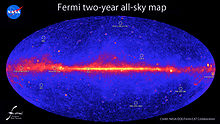
Back تلسكوب الإلكترون المسعري Arabic Calorimetric Electron Telescope French 高エネルギー電子・ガンマ線観測装置 Japanese 고에너지 전자·감마선 관측장치 Korean
 | |
| Alternative names | CALET |
|---|---|
| Organization | JAXA |
| Telescope style | space telescope |

The CALorimetric Electron Telescope (CALET) is a space telescope being mainly used to perform high precision observations of electrons and gamma rays. It tracks the trajectory of electrons, protons, nuclei, and gamma rays and measures their direction, charge and energy, which may help understand the nature of dark matter or nearby sources of high-energy particle acceleration.[2]
The mission was developed and sponsored by the Japan Aerospace Exploration Agency (JAXA), involving teams from Japan, Italy, and the United States. CALET was launched aboard JAXA's H-II Transfer Vehicle Kounotori 5 (HTV-5) on 19 August 2015, and was placed on the International Space Station's Japanese Kibo module.
- ^ "NASA - Fermi's Latest Gamma-ray Census Highlights Cosmic Mysteries". www.nasa.gov. Retrieved 2015-05-31.
- ^ Dunn, Andrea (9 October 2014). "Dark Matter and Particle Acceleration in Near Space". NASA News. Archived from the original on 2016-09-12. Retrieved 2015-11-10.